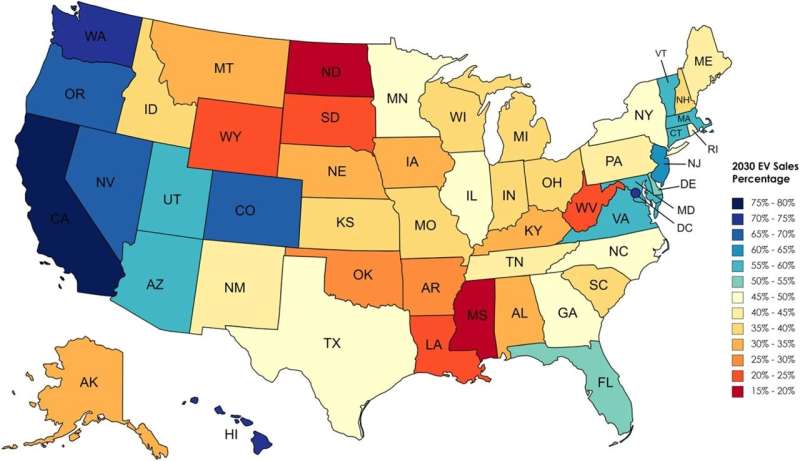This article has been reviewed according to Science X's editorial process and policies. Editors have highlighted the following attributes while ensuring the content's credibility:
fact-checked
peer-reviewed publication
trusted source
proofread
Decarbonizing light-duty transportation in the US: Study reveals strategies to achieve goal

One of the goals outlined by the Biden administration's National Climate Task Force in 2021 was to reduce U.S. greenhouse gas emissions to 50%–52% below 2005 levels by 2030.
Now, a University of Michigan study investigates one of the strategies to achieve this goal, which is to increase new vehicle sales to 50% electric by 2030. The study also reveals a path to meeting the targets.
The new study, published in the journal Nature Communications, investigated the 50% electric vehicle sales target, modeling how much transportation sector emissions would fall by 2030 if that target is met.
U-M researchers found that meeting greenhouse gas emissions goals for light-duty vehicles, which are passenger vehicles such as cars and trucks, is possible, but not just by increasing EV sales.
"Transportation is the highest emitting sector in the U.S., with the majority of emissions coming from light-duty vehicles. Fortunately, there is a clear path to decarbonizing light-duty transportation," said Maxwell Woody, lead author of the study and research assistant at the Center for Sustainable Systems at U-M's School for Environment and Sustainability.
"Our study finds that it will take a combination of strategies working together to create a greater impact than each strategy can have individually."
According to the study, the U.S. will reach a 25% reduction in light-duty vehicle emissions by 2030 if the 50% EV sales target is met. A reduction of 45% is possible by 2035, reaching 50% shortly thereafter if EV sales and grid decarbonization goals are both met.
This suggests that, to accelerate the reduction of emissions and meet goals on time, additional strategies should be implemented. Additional strategies include reducing vehicle production emissions, vehicle size and the number of miles traveled in vehicles, which can be done by working remotely or shifting to less carbon-intensive modes of transportation such as walking, biking or taking public transportation.
There's also a need to continue improving gas and EV fuel economies, meaning that in the process of fleet turnover, attention will need to be given to gas vehicle fuel economy standards. This is because fleet turnover takes time, as does the ramping up of EV production.
"Electrifying vehicles is essential, but not enough," Woody said. "We need to maintain emissions standards for gasoline vehicles, continue cleaning the electric grid, and invest in walkable, bikeable and transit-oriented cities.
"In the short term, the impact of EV sales is limited because of how long it takes to replace vehicles. For example, if the 50% sales goal is met in 2030, that may mean only 10% of the vehicles on the road are electric. This is because vehicles last nearly 20 years on average in the U.S."
To come to these conclusions, the researchers combined several different models. They built a vehicle stock model that uses sales projections by state and vehicle survival curves (how long a vehicle is expected to last) to construct the U.S. light-duty vehicle fleet.
They then built an emissions model that estimates the total emissions from all the vehicles in the stock model each year, which depends on how much the vehicles are driven, how fuel efficient the vehicles are, and for the electric vehicles, what mixture of technologies are producing the electricity used to charge the vehicle. The model also includes emissions from producing the vehicles themselves, not just the emissions from driving the vehicles.
This study was the first to quantify the gap between the stated U.S. vehicle electrification goals and the U.S. economy-wide decarbonization goals. It was also the first to focus on shorter-term goals rather than 2050 targets and the first to model the EV transition for each state rather than the country as a whole.
In addition, the study incorporated updated electric grid decarbonization scenarios that better reflect recent targets, such as the Biden administration's goal of 100% clean electricity by 2035.
"This study examined EV sales trajectories for each state in the U.S. with California leading, along with 14 other states that have set more aggressive sales goals than the federal government. Light-duty vehicles are less difficult to decarbonize than other transportation modes, such as aircraft and ships, so it is particularly important to support industry and government initiatives to accelerate EV adoption," said study senior author Greg Keoleian, professor of environment and sustainability and co-director of the Center for Sustainable Systems.
"Ultimately, growth in EV sales is dependent on the new vehicle purchasing decisions of individual consumers. Those households that have the economic means to buy new electric vehicles have an important opportunity to address our climate emergency by speeding up the replacement of carbon-intensive internal combustion engine vehicles."
More information: Maxwell Woody et al, Decarbonization potential of electrifying 50% of U.S. light-duty vehicle sales by 2030, Nature Communications (2023). DOI: 10.1038/s41467-023-42893-0


















